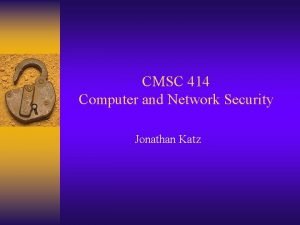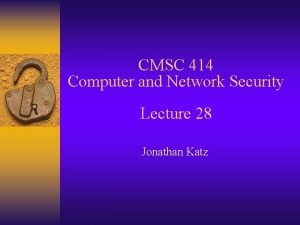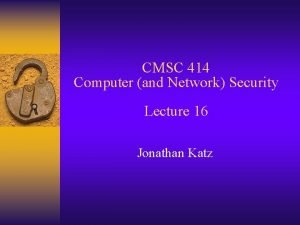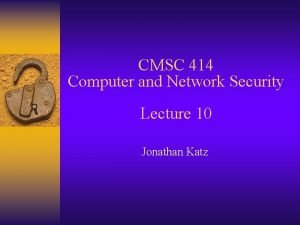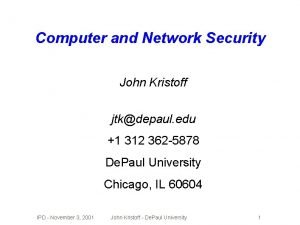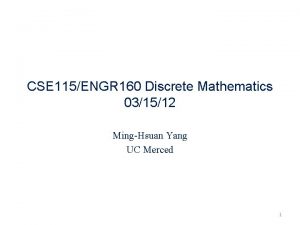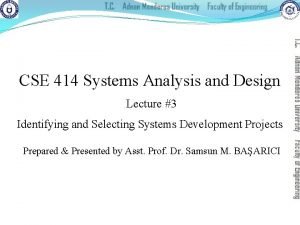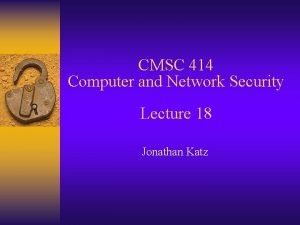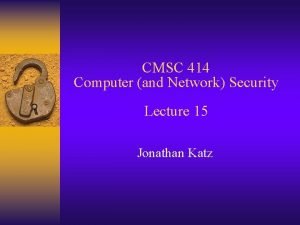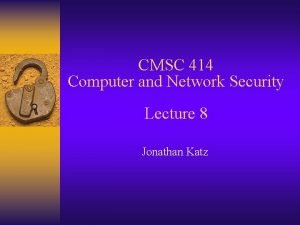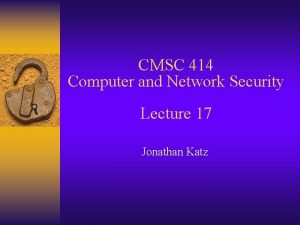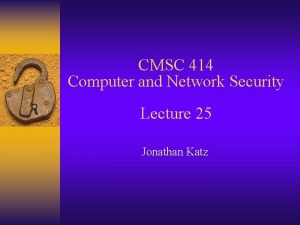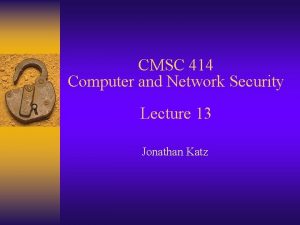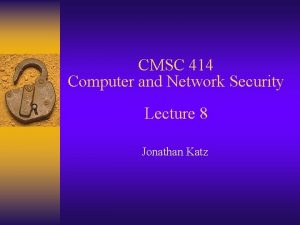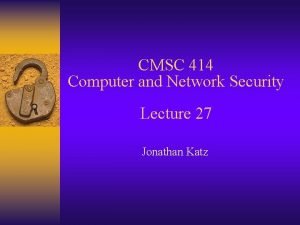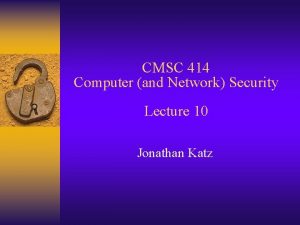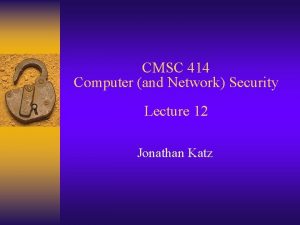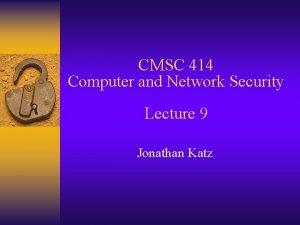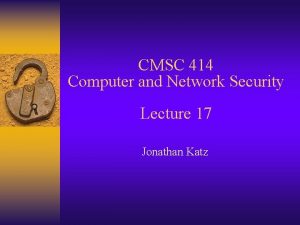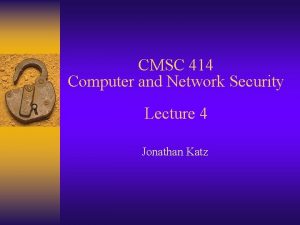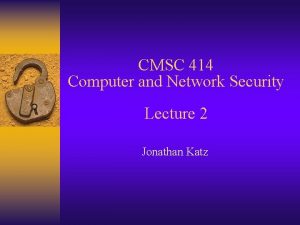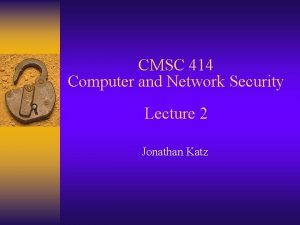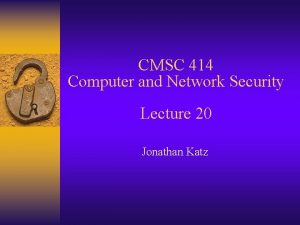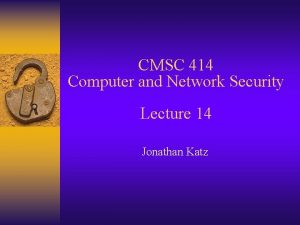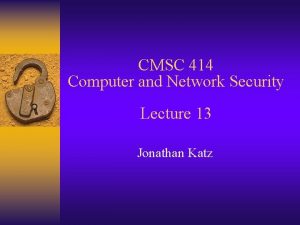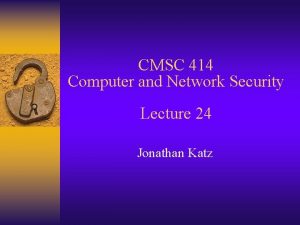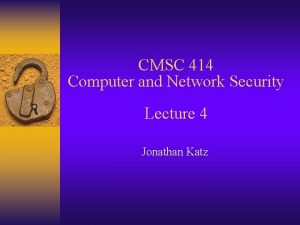CMSC 414 Computer and Network Security Lecture 2


























- Slides: 26

CMSC 414 Computer and Network Security Lecture 2 Jonathan Katz

JCE tutorial ¨ In class next Tuesday

A high-level survey of cryptography

Caveat ¨ Everything I present will be (relatively) informal – I may simplify, but I will try not to say anything that is an outright lie… ¨ Cryptography is about precise definitions, formal models, and rigorous proofs of security (which we will not cover here) – For more details, take CMSC 456 with me (or read my book)!

Goals of cryptography ¨ Crypto deals primarily with three goals: – Confidentiality – Integrity (of data) – Authentication (of resources, people, systems) ¨ Other goals also considered – E. g. , non-repudiation – E-cash (e. g. , double spending) – General secure multi-party computation – Anonymity – …

Private- vs. public-key settings ¨ For the basic goals of confidentiality and integrity, there are two settings: – Private-key / shared-key / symmetric-key / secret-key – Public-key ¨ The private-key setting is the “classical” one (thousands of years old) ¨ The public-key setting dates to the 1970 s

Private-key cryptography ¨ The communicating parties share some information that is random and secret – This shared information is called a key – Key is not known to an attacker – This key must be shared (somehow) in advance of their communication

To emphasize ¨ Alice and Bob share a key K – Must be shared securely – Must be completely random – Must be kept completely secret from attacker ¨ We don’t discuss (for now) how they do this – You can imagine they meet on a dark street corner and Alice hands a USB device (with a key on it) to Bob

Private-key cryptography ¨ For confidentiality: – Private-key (symmetric-key) encryption ¨ For data integrity: – Message authentication codes – (archaic: cryptographic checksums)

Canonical applications ¨ Two (or more) distinct parties communicating over an insecure network – E. g. , secure communication ¨ A single party who is communicating “with itself” over time – E. g. , secure storage

Bob Alice K K shared info K Bob K

Bob K

Security? ¨ We will specify the exact threat model being addressed ¨ We will also specify the security guarantees that are ensured, within this threat model – Here: informally; CMSC 456: formally ¨ Crucial to understand these issues before crypto can be successfully deployed! – Make sure the stated threat model matches your application – Make sure the security guarantees are what you need

Security through obscurity? ¨ Always assume that the full details of crypto protocols and algorithms are public – Known as Kerckhoffs’ principle – Only secret information is a key ¨ “Security through obscurity” is a bad idea… – True in general; even more true in the case of cryptography – Home-brewed solutions are BAD! – Standardized, widely-accepted solutions are GOOD!

Private-key encryption

Functional definition ¨ Encryption algorithm: – Takes a key and a message (plaintext), and outputs a ciphertext – c EK(m) ¨ Decryption algorithm: – Takes a key and a ciphertext, and outputs a message (or perhaps an error) – m = DK(c) ¨ Correctness: for all K, we have DK(EK(m)) = m ¨ We have not yet said anything about security…

Bob Alice K shared info K Bob Alice c K c EK(m) K m=DK(c)

A classic example: shift cipher ¨ Assume the English uppercase alphabet (no lowercase, punctuation, etc. ) – View letters as numbers in {0, …, 25} ¨ The key is a random letter of the alphabet ¨ Encryption done by addition modulo 26 ¨ Is this secure? – Exhaustive key search – Automated determination of the key

Another example: substitution cipher ¨ The key is a random permutation of the alphabet – Note: key space is huge! ¨ Encryption done in the natural way ¨ Is this secure? – Frequency analysis ¨ A large key space is necessary, but not sufficient, for security

Another example: Vigenere cipher ¨ More complicated version of shift cipher ¨ Believed to be secure for over 100 years ¨ Is it secure? – Index of coincidence method

Moral of the story? ¨ Don’t use “simple” schemes ¨ Don’t use schemes that you design yourself – Use schemes that other people have already designed analyzed…

A fundamental problem ¨ A fundamental problem with “classical” cryptography is that no definition of security was ever specified – It was not even clear what it would mean for an encryption scheme to be “secure” ¨ As a consequence, proving security was not even an option – So how can you know when something is secure?

Defining security? ¨ What is a good definition?

Security goals? ¨ Adversary unable to recover the key – Necessary, but meaningless on its own… ¨ Adversary unable to recover entire plaintext – Good, but is it enough? ¨ Adversary unable to determine any information at all about the plaintext – Formalize? – Sounds great! – Can we achieve it?

Note ¨ Even given our definition, we need to consider the threat model – Multiple messages or a single message? – Passive/active adversary? – Chosen-plaintext attacks?

Next time: the one-time pad; its limitations; overcoming these limitations
 Cmsc 414
Cmsc 414 Cmsc 414
Cmsc 414 Cmsc 414
Cmsc 414 Cmsc 414
Cmsc 414 Computer security 161 cryptocurrency lecture
Computer security 161 cryptocurrency lecture Wireless security in cryptography and network security
Wireless security in cryptography and network security Security security security
Security security security Computer and network security
Computer and network security Osi security services
Osi security services Guide to network security
Guide to network security Electronic mail security in network security
Electronic mail security in network security Security guide to network security fundamentals
Security guide to network security fundamentals Security guide to network security fundamentals
Security guide to network security fundamentals 01:640:244 lecture notes - lecture 15: plat, idah, farad
01:640:244 lecture notes - lecture 15: plat, idah, farad Computer & network security
Computer & network security Gcd of 414 and 662
Gcd of 414 and 662 Types of network topology
Types of network topology Mil-std-414
Mil-std-414 Tabel military standard
Tabel military standard Mil-std 414
Mil-std 414 Pc 414
Pc 414 Cs 414
Cs 414 Cse414
Cse414 Graph neural network lecture
Graph neural network lecture Network management principles and practice
Network management principles and practice E commerce security meaning
E commerce security meaning Computer-aided drug design lecture notes
Computer-aided drug design lecture notes
